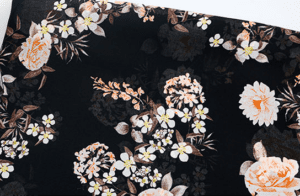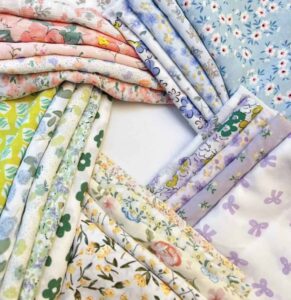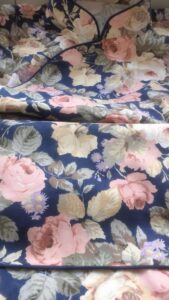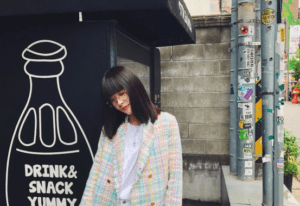Introduction
China is a major country in the design and production of printed fabric products, with a wide range and a large number of light industrial products represented by floral fabrics, wallpapers and carpets in exterior design applications.
In the case of printed fabric products, for example, the printed pattern on the surface of the product is a key element of its design. In some of these products, a part of the design is used as a unit in a two-, three- or four-sided continuous pattern. The two-way continuity in a design patent application means that the unit pattern is repeated in the left, right or top and bottom directions at the same time, while the four-way continuity means that the unit pattern is repeated in the top, bottom, left and right directions at the same time. The three-way continuity is usually found in the field of curtains, wedding dresses, etc., where the fabric is lace on one side and the other three-way continuity is not limited to a border.
In the case of this type of product, it is not possible to represent all of the units contained in the product in the application document due to space constraints. The applicant is therefore permitted to submit a picture of only a certain area of the product, in which the unit design of the product is clearly represented, with a brief description indicating an infinite number of boundaries, such as two consecutive sides or four consecutive quadrants of the product, which is considered to clearly represent the design of the product for which protection is sought.
In the current examination of design patents, it has been argued that all printed fabric products should have design units that are capable of being arranged in successive rows to form a coherent and aesthetically pleasing large pattern. If the units of the design are arranged in two or four directions and do not form a “continuous and harmonious pattern”, this means that the application does not contain a complete unit of the design and no patent can be granted.
In fact, with innovations in printing methods and advances in production technology, not all designs for printed fabric products are two-sided or four-sided, while others have large repetitive unit patterns that are difficult to show clearly in the space of the application document, or have no obvious repetitive units, or are a disorderly repetition of design elements. How should such products be filed when filing a design application? How should the examination be adapted in the light of new design trends? These two issues are emerging as new problems in the field of printed fabrics.
The common fabric products printing method
The characteristics of the design of the product are closely related to the printing method used. Common printing methods include flat screen printing, circular screen printing, roller printing, as well as inkjet printing and transfer printing.
These processes require the preparation of screens and rollers according to the design in advance. When printing, large fabrics are printed continuously by the translation of the screen or the rolling of the screen or roller. The patterns printed by these traditional methods are generally continuous in all directions.
With the development of computer applications, digital printing has recently emerged, digital printing is a digital input device to the desired pattern, the computer colour separation plate system processing, and then by a specific software will be printed on the special dyes to be printed on the fabric after various chemical treatment, so as to obtain the design requirements of a printing technology.
Digital printing is produced using two main methods: digital transfer printing and digital inkjet printing.
In the traditional printing process, the designer usually arranges the pattern units in a regular cycle, and needs to design the ‘pattern return’ (the basic unit pattern) according to the characteristics of the printing equipment, which to a certain extent limits the designer’s talent and play, with less variation. The digital printing technology allows the designer to give full play to his or her design capabilities by no longer being bound by the ‘flower loop’, breaking through the limits of the pattern’s repetitive unit size and allowing for instantaneous and arbitrary rearrangement. It can be disorderly and regular, effectively meeting the needs of consumers for colourful, personalised printed products and laying the foundation for designers to create stylish, individual patterns.
Figure 1a shows an image designed for digital print production, while Figure 1b shows a digital inkjet printing machine producing a number of fabrics with different patterns. As can be seen, digital printing allows for complex variations in colour and curves that can be used to express a variety of artistic effects.5 The design of these patterns is based entirely on the designer’s vision. The design of these patterns is based on the needs of the designer and is not necessarily related to the repetition of the unit pattern.
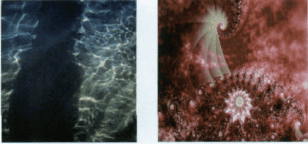
Fig. 1a Digital print design
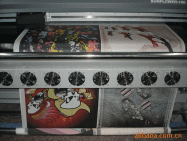
Figure 1b Digital inkjet printing machine
Current misconceptions about printed products in design patent examination
In design applications, it is common to come across applications for printed fabrics. It is argued that fabrics with stitching in such patterns do not exist in the marketplace. There are two reasons for this: firstly, the fabrics are of a certain width and are printed continuously in the length direction with rollers etc. Therefore, is not a fabric with stitching in terms of technology; secondly, according to common sense, the patterns on the fabric are harmonious, continuous and uniform in a large format. Manufacturers will not produce such printed fabrics.
In examining practice, it has been held that the unit pattern of such a print has a patchwork seam and is rigidly joined because the unit pattern is incomplete, and that no patent can be granted. For example, as shown in Figure 2a, an application submitted only the unit pattern of the floral fabric as shown in Figure 2a as the main view, with a brief description stating “continuous in all directions”. The flowers in the pattern are clearly incomplete, and the unit pattern is continuous in all four directions, resulting in a floral fabric pattern as shown in Figure 2b. As the fabric unit pattern in Fig. 2b is ‘rigidly joined’ by stitching, it is challenged that the pattern in Fig. 2a is not a complete unit pattern and the patent is not granted.
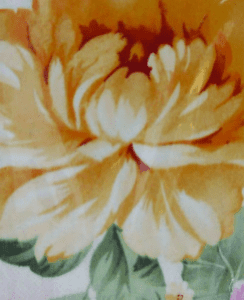
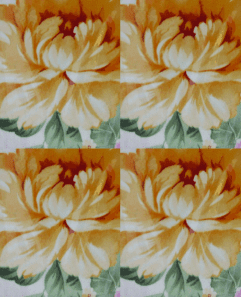
The above views and the way they are handled are open to further exploration.
Firstly, it is clear from an understanding of the printing equipment and processes that it is not impossible to achieve the fabric pattern shown in Fig. 2b. Even with traditional flat screen printing, the effect in Fig. 2b can be achieved by designing a flat screen with a unit pattern according to Fig. 2a; flat screen, circular screen and roller printing can also be done with several unit patterns according to the width of the web. If digital printing is chosen, there is no need to worry about the limitations of the unit pattern, so it is possible to produce a printed fabric with the effect shown in the picture, given the design. It can be argued that reason 1 above is not entirely accurate.
Secondly, consumer aesthetics have evolved towards diversity with the development of technology. Traditional fabrics, with their harmonious and continuous unit patterns, can often be slightly monotonous. Digital printing offers design advantages that are unmatched by traditional printing techniques. For example, with digital technology it is easy to achieve a wide range of individual and diverse printing effects, just as a wallpaper can be varied according to the environment in which it is used, for example, with light and shadow effects, oil painting effects and so on. In addition, the combination of different design tools and forms, such as manual drawing and computer technology, can produce novel effects that are difficult to achieve with a single drawing tool.
In the case of printed products currently available on the market, there are also cases of rigid stitching of unit patterns, for example in the case of single prints, patchwork, intermediate fabrics cut to make smaller products, etc. This is illustrated in Figure 3.
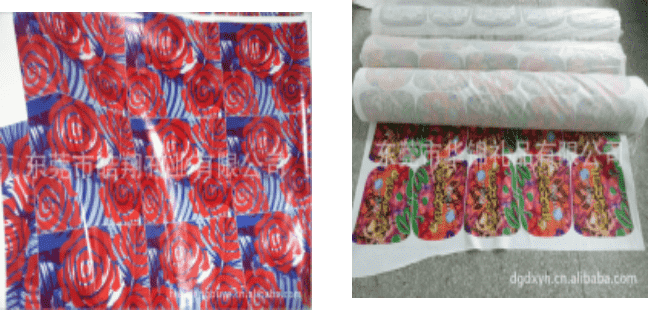
Therefore, from a market development point of view, printed fabrics are already diversifying and personalising their patterns, and there is a demand and development trend for patchwork patterns. In addition, from the perspective of the patent application strategy, designs that are not popular at present may become popular in the future, and their design value cannot be denied just because they are not currently recognised in the market. Therefore, reason two above is also untenable.
How to file a design patent application for printed products Explore
As can be seen from the above analysis, the design of printed products has become increasingly complex with the development of printing technology, consumer aesthetics and the level of pattern design. In the case of design applications, the “unit pattern + four-sided continuity” submission method alone does not adequately convey the design of printed products.
In the case of large ‘floral’ prints, or where the design elements are randomly arranged and there is no obvious unit pattern, it may also be difficult to rely on a single image.
Following the third amendment to the Patent Act in 2008, the legal status of the brief description has increased and can be used to explain and illustrate the design of a product in a picture or photograph. In the case of printed fabric products, where the basic design elements are given in a photograph, but the picture is too limited in size to show the entire design clearly, it is appropriate to explain the design in a brief description.
The fourth amendment to the Patent Law, which came into force on 1 June 2021, introduced partial designs as an object of protection. Following the implementation of the amended patent law, printed fabric products may request protection in the form of partial designs for relatively complete patterns or pattern units. However, it is not yet clear how partial designs will be protected, and it is therefore uncertain whether any partial design can be protected separately. This will need to be clarified in judicial practice when the relevant legal regulations are further developed.
In summary, at this stage and after partial design protection, there are four ways of filing applications for printed fabric products.
1. the unit pattern is presented in the form of an overall view + local enlargements.
2. Multiple images are allowed to be combined to represent a larger flower arrangement or a larger monogram design and are described in a brief description. For example, an applicant may submit 9 views of a larger monogram, broken into 3 parts horizontally and vertically, and state that “Main view 1 – Main view 9 can be combined into a monogram from left to right, top to bottom 3 x 3”.
3. In the brief description, a brief description of the arrangement of the design elements in the drawing is allowed in conjunction with the submitted image. For example, “The figure has a random arrangement of dots and stars with an infinite boundary”.
4. the protection of relatively complete parts of a pattern or graphic unit through partial design.
In the future, it may be possible to explore new ways of submitting images or photographs as a computer file, which would not be limited by the size of the paper file and might be more conducive to protecting the work of designers of printed fabric products.
Conclusion
China is a major producer and designer of printed fabric products. With the development of design standards and the diversification of consumer needs, the patterns and designs of such products are developing in a diversified manner. As an important part of intellectual property protection, design patents should be changed in accordance with the changes in the industry and market, and corresponding regulations and policies should be adjusted to provide more reasonable protection for printed fabric products, so as to help China become a strong country in production and design.



















